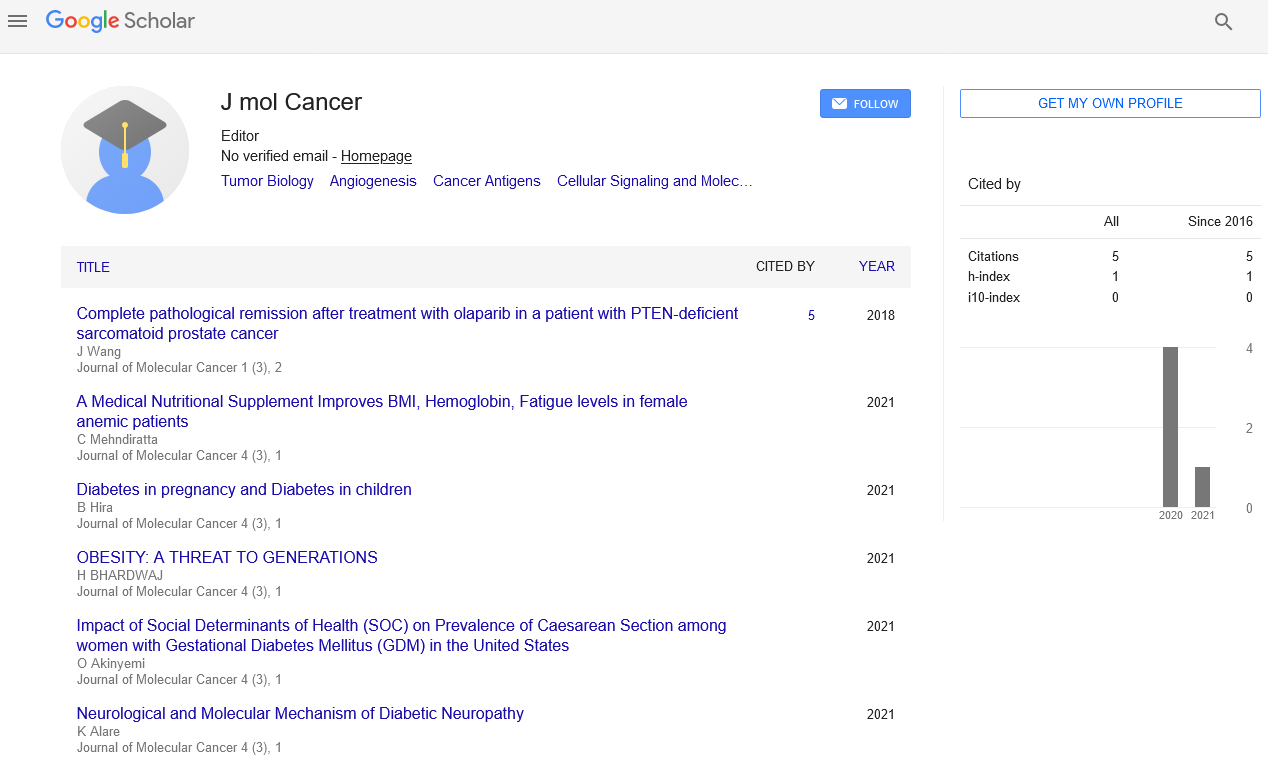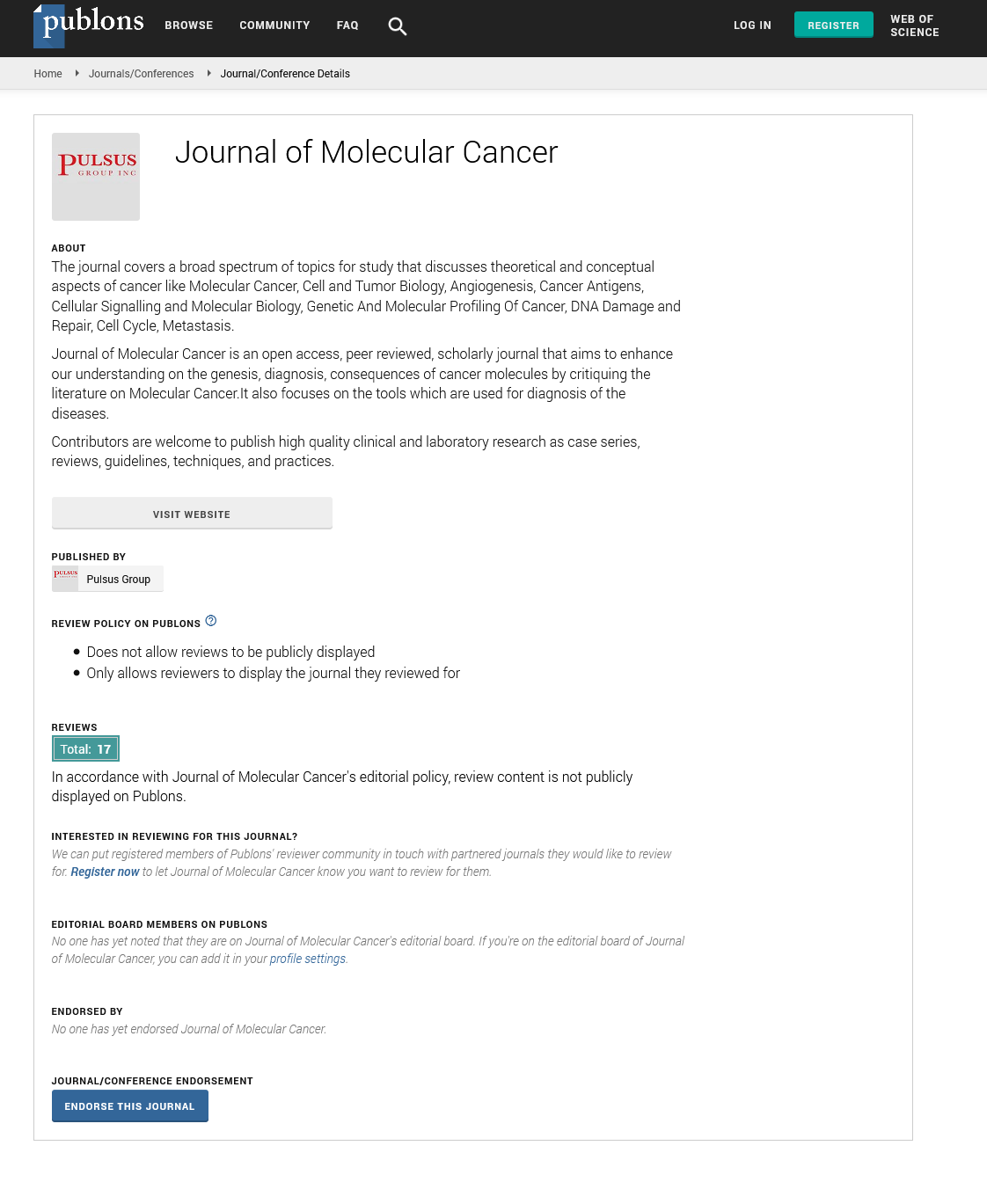T cells communicating antigen receptor focusing on glypican-2
Received: 08-Jan-2022, Manuscript No. PULJMC-22-4315; Editor assigned: 10-Jan-2022, Pre QC No. PULJMC-22-4315(PQ); Accepted Date: Jan 10, 2022; Reviewed: 15-Jan-2022 QC No. PULJMC-22-4315; Revised: 11-Jan-2022, Manuscript No. PULJMC-22-4315(R); Published: 31-Jan-2022, DOI: doi:10.37532/puljmc.22.5.1.1
Citation: Grey A. T cells communicating antigen receptor focusing on glypican-2. J Mol Cancer. 2022;5(1):1.
This open-access article is distributed under the terms of the Creative Commons Attribution Non-Commercial License (CC BY-NC) (http://creativecommons.org/licenses/by-nc/4.0/), which permits reuse, distribution and reproduction of the article, provided that the original work is properly cited and the reuse is restricted to noncommercial purposes. For commercial reuse, contact reprints@pulsus.com
Abstract
Pediatric malignant growths regularly imitate fetal tissues and express proteins ordinarily quieted postnatally that could fill in as safe targets. We created T Cells Communicating Antigen Receptors (CARs) focusing on Glypican-2 (GPC2), a fetal antigen communicated on Neuroblastoma (NB) and a few other strong growths. Vehicles designed utilizing standard plans control NBs with transgenic GPC2 overexpression, however not those communicating clinically important GPC2 site thickness (∼5,000 atoms/ cell, range 1-6 × 103). Iterative designing of Transmembrane (TM) and co-stimulatory areas in addition to overexpression of c-Jun brought down the GPC2-CAR antigen thickness limit, empowering intense and solid destruction of NBs communicating clinically applicable GPC2 antigen thickness, without poisonousness. These examinations feature the basic interchange between CAR plan and antigen thickness limit, exhibit intense adequacy and security of a lead GPC2-CAR applicant reasonable for clinical testing, and certification oncofetal antigens as a promising class of focuses for CAR T cell treatment of strong cancers.
Key Words
Neuroblastoma; Cerebroglycan; Bone marrow; Tisagenlecleucel
Introduction
Immune system microorganisms Communicating Illusory Antigen Receptors (CARs) focusing on high and homogeneously communicated B genealogy antigens intervene great clinical advantages with OK harmfulness. Vehicles designed involving customary plans manifest high antigen thickness necessities for full enactment because of restricted Zap70 enrollment to the invulnerable neurotransmitter, however the antigen thickness limits can be tuned by adjusting the CAR plan. Plans that improve signal strength, changes to the transmembrane space, and c-Jun overexpression bring down the antigen thickness edges, yet it stays obscure whether CAR T cells tuned for low antigen thickness can really target antigen densities present on human strong cancers and would try not to focus of typical tissues. Pediatric strong growths and mind cancers frequently emerge with regards to slowed down formative projects and express fetal antigens with restricted articulation on post pregnancy, non-dangerous tissues. Cerebroglycan or Glypican-2 (GPC2), a prototypical oncofetal target, is exceptionally communicated in the creating sensory system, where it fills in as a flagging co-receptor directing cell development. GPC2 is overexpressed on Neuroblastoma (NB) and other strong growths, however shows restricted post pregnancy articulation. GPC2- CARs designed utilizing standard plans controlled NB cell lines designed to overexpress GPC2 however not non-designed cell lines due to subthreshold antigen thickness. Utilizing stream cytometry to gauge GPC2 antigen thickness on metastatic NBs in pediatric Bone Marrow (BM) tests, we show that GPC2 antigen thickness in clinical examples is beneath the limit expected to control cancer development for generally planned GPC2-CAR T cells. Consecutive GPC2-CAR plan alterations altogether brought down the antigen thickness limit, yielding lead competitors fit for noteworthy NB relapse and supported infectious prevention in a few growth models communicating clinically pertinent GPC2 levels, without poisonousness. This work approves the speculation that cutting edge CAR designing can tune antigen thickness edges and convey therapeutics fit for focusing of non freak, non-heredity cell-surface antigens communicated on strong cancers while saving typical tissues.
Conclusion
We recognized three novel enemies of GPC2 Single-Chain Variable Pieces (scFvs) (GPC2.19, GPC2.27, GPC2.D4) inside a human innocent AntigenRestricting Part (Fab) phage library and a fourth recently detailed (GPC2. D3). Fabs fusing every one of the four scFvs were thermostable; displayed high restricting affinities toward human GPC2 and GPC2.19, GPC2.D3, and GPC2.D4 additionally bound murine GPC2. GPC2.D4 and GPC2.27 require C-terminal deposits (493-553) for restricting. GPC2.19 and GPC2. D3 share covering epitopes, including deposits 396-400, known parts of GPC2.D3. Utilizing a CD8α pivot/Transmembrane (TM) and 4-1BB costimulatory area spine that imitates tisagenlecleucel, a FDA-supported CD19- CAR dynamic against B Cell Intense Lymphoblastic Leukemia (B-ALL), we designed T cells to communicate GPC2-CARs fusing each scFv, in both VH/ VL and VL/VH directions. In light of great biophysical properties; powerful articulation in essential, enacted T cells; killing limit; low standard IFNγ and high antigen-instigated cytokine creation, GPC2.19-and GPC2.D3- CAR T cells with VL/VH directions without Fc-changed spacer areas were focused on for additional testing. We next analyzed antigen thickness limits for GPC2.19-CARs versus a CD19-CAR copying tisagenlecleucel (FMC63- CAR) utilizing cancer lines communicating antigen densities like those of GPC2 and CD19, separately. The two CARs showed a comparable reliance on antigen thickness, as both killed antigenlo focuses at 1:1 proportions yet neither created critical cytokines in reactions to antigenlo targets. These outcomes exhibit that GPC2-CARs joining a standard CAR configuration used in the FDA-endorsed tisagenlecleucel show huge and explicit GPC2- coordinated movement, yet strength differed significantly relying on antigen thickness, featuring a basic need to quantitate GPC2 antigen thickness on human NBs to anticipate the potential for clinical viability.






